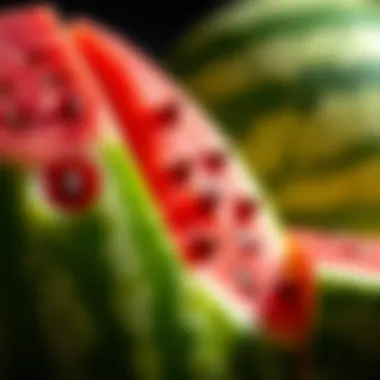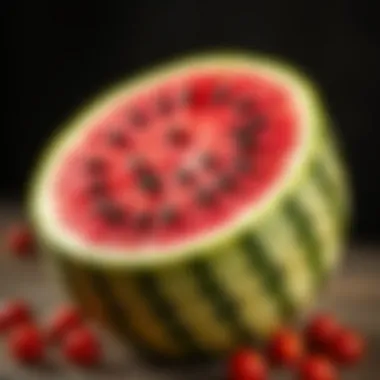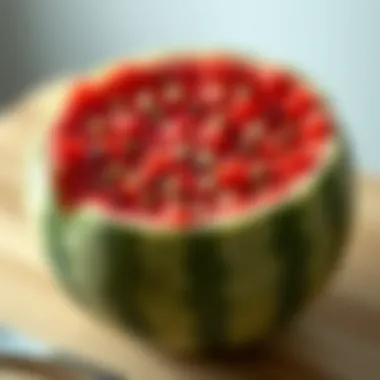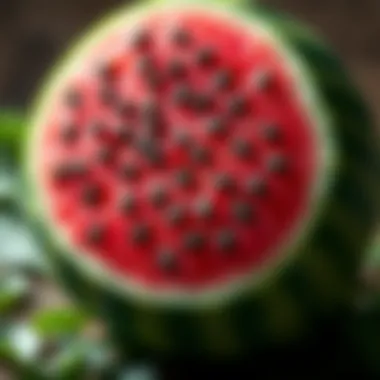Exploring the Unique Aspects of Seeded Watermelons


Intro
Watermelon with seeds stands apart in a world saturated with seedless options. It boasts a rich history intertwined with cultural traditions from all corners of the globe. As summer rolls in, so does the quest for refreshing treats, and this vibrant fruit emerges as a cherished option.
Throughout the years, the debate between seeded and seedless watermelons has gained momentum, often favoring the convenience of seedless varieties. However, the watermelon with seeds offers a flavor profile and authenticity that can't be duplicated. It is not merely about nostalgia; it's about the texture, crunch, and, most importantly, the burst of flavor locked inside those seeds.
In this piece, we aim to explore the adventures of enjoying seeded watermelon — from its surprising nutritional benefits to innovative recipes and practical tips for preparing this delightful fruit. By the time you're done reading, you'll see watermelon in a whole new light, noticing the subtle intricacies that elevate it beyond just another summer snack.
Understanding Watermelon Varieties
Watermelon is a summertime staple that brings joy to those hot sunny days. As we explore this fruit, it’s essential to grasp not just the distinction between different watermelons but also why it matters to consumers and enthusiasts alike. Understanding watermelon varieties goes beyond just picking one at the grocery store; it encompasses flavor, texture, and even the nutrients one can derive from them.
The Seeded vs. Seedless Debate
The conversation around watermelon varieties often begins with the ongoing debate: seeded vs. seedless. Seeded watermelons have been around for centuries, and many claim they offer a more rich and authentic taste. These watermelons generally contain a blend of sweet and crisp flesh that can be a delight when bitten into. Some enthusiasts and traditionalists argue that the texture and mouth-feel of seeds add a unique crunch that is missing in seedless varieties.
In contrast, seedless watermelons, which have gained immense popularity due to their convenience, come with a different flavor profile. Many people find them easier to enjoy at parties or family picnics, as they eliminate the hassle of spitting out seeds. However, some consumers feel the flavor can sometimes be less pronounced and more uniform. This ongoing tug-of-war can influence purchasing choices and also plays into how watermelon is served in recipes.
Historical Context of Watermelons
Tracing back the origins of watermelons provides a fascinating glance into how cultivating preferences have changed over time. Watermelons are believed to have originated in Africa over 5,000 years ago, becoming a vital source of hydration for early civilizations. Ancient Egyptians prized watermelons, as they were often found in tombs as offerings for the afterlife. The introduction of watermelon to the Americas in the 16th century marked a turning point. With cultivation growing across various climates, regional preferences also began to develop. In parts of the United States, traditional seeded types have remained a favorite due to cultural practices and heritage, while globally, seedless varieties have come to dominate markets.
Regions of Cultivation and Their Influence
The regions where watermelons are cultivated provide significant insights into the flavors and types available. Different climates dictate the sweetness and water content of the fruit, which plays a crucial role in its overall taste. For instance, watermelons from Florida tend to be moist and sweet, while those from Texas might pack a bit more of a crunch. Moreover, environmental factors such as soil conditions and local farming practices can impact not only the size but also the flavors of the watermelons produced. Farmers who stick to traditional methods might still yield seedier varieties, while those embracing modern techniques lean towards seedless types. As consumers, understanding these nuances can enhance the selection process, leading to a more gratifying experience when enjoying this beloved summer fruit.
Nutritional Benefits of Watermelon with Seeds
Watermelons with seeds often take a backseat to their seedless counterparts, but these fruits pack a nutritional punch that should not be overlooked. In many ways, the presence of seeds elevates their health benefits. This section delves into crucial aspects of these benefits, emphasizing why they're worthy of consideration.
Vitamins and Minerals
Watermelon isn’t just a refreshing treat; it’s also loaded with essential vitamins and minerals. A typical serving of seeded watermelon boasts impressive quantities of Vitamin C, which is vital for maintaining a healthy immune system. You can also find Vitamin A, promoting eye health, and several B vitamins crucial in energy production and red blood cell formation. Additionally, potassium in watermelon helps regulate blood pressure, proving that indulging in this juicy delight can be good for your heart as well.
The seeds themselves are also a treasure trove, rich in magnesium, which plays a role in over 300 enzymatic reactions in the body.
"One slice not only refreshes you but also fuels your body with what it needs to keep running smoothly."
Health Benefits of Consuming Seeds
High in Fiber
Fiber is a hot topic in the health world; it’s critical for digestion and plays an important role in maintaining a healthy gut. Consuming the seeds of watermelons means you’re getting a hefty dose of dietary fiber. This is significant because fiber helps prevent constipation, promotes a feeling of fullness, and can aid in regulating blood sugar levels. Incorporating this high-fiber option into your diet could be advantageous for anyone looking to enhance their overall digestive health. However, seeds do have a certain texture that might take some getting used to, depending on individual preferences.
Source of Protein
When it comes to plant-derived protein sources, watermelon seeds are a surprising contender. They contain various essential amino acids necessary for your body’s repair and growth. This makes them particularly valuable for those who follow vegetarian or vegan diets. The protein content contributes to muscle growth and repair, making them a good post-workout snack. Although they don’t match the protein levels found in animal products, they still add a substantial boost to your overall protein intake. This is a key part of why including seeds in your watermelon consumption is beneficial.
Aids Digestion


Not only does fiber play a significant role in digestion, but watermelon seeds also contain fats that can help lubricate the digestive tract, allowing for smoother digestion overall. This dual action means that enjoying watermelon with seeds might help you keep your digestive processes in check. However, one needs to chew them thoroughly; otherwise, they don’t break down as effectively, and their benefits could be diminished.
Caloric Content Comparisons
One of the frequent concerns related to health and diet is evaluating caloric intake. When comparing seeded and seedless watermelons, there’s nothing too drastically different in the caloric counts, but it’s worth nothing that the presence of seeds does add a few extra calories along with their nutritional benefits. Generally, 100 grams of seeded watermelon contains about 30 calories, while seedless counterparts are slightly less dense in this regard. However, what the seeds bring in terms of added nutrients can outweigh those extra calories, especially given their health benefits.
Taking the leap to incorporate seeded watermelon into your diet might seem small, but it paves the way for a better understanding of nutrition and how these tiny seeds can contribute significantly to overall health. With a blend of vitamins, protein, and fiber, watermelon seeds could very well be the unsung heroes of the fruit family.
Flavor Profiles of Seeded Watermelons
When it comes to culinary exploration, flavor profiles of seeded watermelons bear significant weight. These profiles do not only inform taste preferences but also influence how the fruit is utilized in various dishes and beverage concoctions. An understanding of the subtle taste variabilities, textural differences, and pairing possibilities is paramount for anyone looking to grasp the full essence of this refreshing fruit.
Taste Variability among Different Varieties
Seeded watermelons exhibit a wide range of flavors; some lean toward the sweetness of honey while others may have a tart undertone reminiscent of summer berries. This variability arises from the variety itself, the soil it's grown in, and even the climatic conditions during its growth. For instance, the Charleston Grey is known for its crisp, sweet flavor, while the Black Diamond tends to offer a denser sweetness, often described as a dessert on its own.
Moreover, slight differences in growing practices can also impact flavor. A watermelon that’s sun-ripened on a hot day might taste sweeter due to the increased sugar concentration. Therefore, tasting different varieties can lead to surprising discoveries. As one watermelon farmer remarked, "Not all watermelons are created equal; each bite can tell a different story."
Textural Differences
Textural profile is another cornerstone when assessing seeded watermelons. Some varieties offer a crisp bite that snaps distinctively when bitten into, while others present a more squishy mouthfeel. Crimson Sweet, with its succulent juiciness, has a noticeable crunch that adds to the eating experience, while a variety like Sugar Baby gives a smoother, silkier texture that glides over the palate.
Ownership of the right texture can make or break a dish. A textured watermelon may work well in salads, providing that crunch factor that contrasts with creamy components, while a soft, juicy one might be the ideal candidate for smoothies or juices, where a more liquid consistency is desired. Understanding these textures helps one choose the right watermelon for each specific culinary application.
Pairing with Other Ingredients
Now, once you have a handle on the flavors and textures, the next step is considering potential pairings. Watermelon, with its naturally sweet profile, presents myriad opportunities for delicious combinations. Pairing with feta cheese brings a salinity that serves as an excellent counterbalance to the fruit�’s sweetness. Tossing watermelon into a spinach salad, alongside crunchy nuts, creates a harmony of flavors and textures that play well together.
In beverages, blending watermelon with citrus fruits can elevate flavors, bouncing between sweet and tart moments that dance on the tongue. Some culinary experiments even combine watermelon with balsamic vinegar, creating a surprising complexity that can leave a lasting impression. The playful nature of watermelon allows for a multitude of exciting pairings, transforming simple snacks into gourmet experiences.
"Watermelon is versatile; it melds beautifully with both savory and sweet companions, showcasing its adaptability like no other fruit."
These aspects of flavor profiles regarding seeded watermelons lend themselves to greater appreciation and understanding, enabling food lovers to not only enjoy the fruit but also incorporate it into various culinary landscapes.
Practical Considerations in Selection
When venturing into the world of seed-included watermelons, a few practical considerations are key to ensuring you choose a fruit that’s not just good looking but also bursting with flavor. The sheer size of watermelon varieties can be overwhelming at the market, but making informed choices can lead to a more satisfying experience.
Identifying Quality Seeded Watermelons
Selecting quality seeded watermelons begins with a good ol’ sensory check. The first rule of thumb? Give it a thump! A ripe watermelon should produce a deep, hollow sound when you hit it. This indicates ripeness, as a dull sound often means the fruit is underdone.
Next comes the appearance. Look for a watermelon with a smooth skin, free from dents, cracks, or soft spots. Each watermelon has a field spot, the area that rested on the ground while growing. A creamy yellow field spot signals ripeness, while a white one may indicate the fruit was picked too soon.
Additionally, take into account the shape; a symmetrical, rounded shape often signifies a well-developed fruit, while irregular shapes may suggest uneven growth. Keep an eye on the size as well; large varieties like the Crimson Sweet or the Moon and Stars tend to have a lower seed content compared to smaller, traditional varieties, which might offer a more intense flavor experience despite the seeds.
Choosing the Right Size and Ripeness


Deciding on the right size can be a bit of a balancing act. Larger watermelons might seem like a better deal, but if you’re just feeding a few folks at a summer barbecue, a smaller one would suffice and potentially be more flavorful. On the flip side, a generously sized watermelon is perfect for larger gatherings or family picnics. It’s important to consider just how much watermelon you’ll realistically consume before it goes to waste.
Ripeness is another crucial factor. This can often be a guessing game, but there are tricks to help you out. First, check the tendril, a curly stem that typically dries and turns brown when the fruit is ripe. If it’s still green, you might be in for a disappointment. Though it’s not a foolproof method, it can give you a leg-up in the grocery store.
Storage and Shelf Life
Once you’ve picked the perfect watermelon, knowing how to store it can make all the difference in preserving its flavor and texture. Uncut, a watermelon can be stored at room temperature for about one to two weeks. However, if you live in a hot climate, direct sunlight can speed up the ripening process. It's best to keep it in a cool, shaded spot.
After slicing into it, wrap the leftover sections in plastic wrap or foil and refrigerate. Cut watermelon can typically last for about three to five days in the fridge. Keep in mind, the more the air gets to it, the faster it will begin to lose that luscious flavor we all love so much.
"The best way to enjoy a watermelon is fresh, preferably straight from the field to the table."
This ancient fruit offers a delightful mix of hydration and sweetness, making it a favorite among many, but taking these simple considerations into account can elevate your experience with the classic summer treat.
Preparing Watermelon with Seeds
The act of preparing watermelon with seeds isn’t just a matter of cutting a fruit; it’s an art that enriches the whole experience of enjoying this delightful summer classic. Understanding how to prepare it properly not only enhances the taste but also helps you appreciate its unique qualities. With a bit of know-how, you can take full advantage of what seeded watermelons have to offer, from their texture to their flavor.
To start with, let’s talk about the method of cutting. Knowing how to slice watermelon effectively can turn an ordinary eat-in-the-park moment into an extraordinary gathering. The way you cut watermelon can affect both its presentation and ease of serving. Using techniques that maintain the integrity of the fruit is vital; no one wants a mushy mess on their picnic blanket.
Methods of Cutting and Serving
When it comes to cutting watermelon, there are several methods you can apply. One popular technique is the wedge method. To perform this, you first cut the watermelon in half lengthwise, then cut each half into triangular wedges. This creates easy-to-hold slices, perfect for casual picnics or gatherings. Another favored approach is the cube method, where you slice the watermelon into uniform cubes. This can be especially useful for fruit salads or as a refreshing snack that can be skewer for easy serving.
Regardless of the method chosen, it’s crucial to ensure your knife is sharp. A dull knife is more of a liability than anything, often leading to jagged cuts and potential injuries. Careful preparation also extends to how you serve it. Placing slices or cubes in decorative bowls or platters can give an extra touch to your presentation.
Creative Uses in Recipes
Watermelon is more than a simple refreshing fruit; it’s a versatile ingredient in a wide variety of dishes. Below are a few creative avenues to explore with watermelon in your kitchen.
Salads and Salsas
Salads and salsas featuring watermelon can be a fantastic way to combine different flavors and textures. The crisp, juicy bites of watermelon contrast beautifully with sharper tastes, such as feta cheese or spicy jalape�ños. It’s a favored choice for summer gatherings as it can be served chilled, providing a refreshing respite from the heat. By including ingredients like mint or basil, you can create sophisticated flavor profiles that elevate the dish to something memorable. Plus, it’s a visually striking dish that adds color to your table.
Juices and Smoothies
Juices and smoothies made from watermelon are great for hydration and wellness. The high water content of watermelon helps create refreshing beverages that are light yet nourishing. Blending watermelon with other fruits like bananas or strawberries can yield a unique taste experience, perfect for hot days. A unique aspect of using watermelon this way is the simple method of preparation; just chop it, blend, and serve! The only downside might be the quick consumption required, as watermelon juice doesn’t keep too well after mixing.
Grilled Watermelon Dishes
Yes, you read right! Grilling watermelon can add a smoky flavor that brings out its natural sugars. This technique works especially well for savory dishes. A standout dish is grilled watermelon served as part of a salad with arugula and goat cheese drizzled with balsamic glaze. This added layer of flavor helps showcase the unique taste of seeded watermelon. However, one must be cautious as not all watermelons are suitable for grilling; it’s best to choose ripe, firm ones for the best results.
Innovative Serving Ideas
Innovative serving ideas can take your watermelon presentation to a whole new level. From making watermelon sticks for circus-themed parties to creating watermelon bowls for a thematic presentation, the possibilities are endless. Consider freezing small cubes of watermelon for a quirky addition to summer drinks or using them in cocktails to keep your beverage chilled without diluting it.
Each new way of serving watermelon noted here reflects the fruit's vast potential, proving that seeded watermelons can be as versatile as they are delicious.


Cultural Significance of Watermelon
The cultural significance of watermelon extends far beyond its role as a refreshing summer treat. In various societies, this fruit represents more than just a delightful snack; it embodies themes of community, celebration, and even prosperity. The fact that watermelon features prominently in summer picnics and family gatherings shows its capacity to bring people together.
Watermelons in Festivals and Traditions
Watermelons often find themselves at the heart of cultural festivities around the world. For example, in parts of the Southern United States, watermelon-eating contests are a staple of summer fairs. These events are not merely competitive; they invoke a spirit of camaraderie among participants and spectators alike. The joy of laughing and cheering for friends, family, or complete strangers as they dive into a gigantic watermelon creates cherished memories.
Meanwhile, in Japan, the tradition of suikawari—a game resembling piñata-style festivities—adds a unique twist to how watermelons are celebrated. Blindfolded participants take turns trying to split a watermelon open, which not only provides a fun activity but also signifies the arrival of summer.
"In many cultures, the watermelon acts as a symbol of abundance, joy, and the sweetness of life."
Symbolism in Various Cultures
Watermelon has different meanings across cultures. In African cultures, expressing the abundance and generosity of nature, the fruit symbolizes prosperity. Many African harvest festivals incorporate watermelon, celebrating the agricultural soul of the community. In some Middle Eastern cultures, it’s a symbol of peace and hospitality; a watermelon is often served to guests as a gesture of goodwill and friendship.
Meanwhile, in Asian traditions, particularly in China and Vietnam, watermelon represents good fortune. During New Year celebrations, families display watermelons as part of their decorations, believing that it will attract good luck for the upcoming year. The seeds, often seen scattered in the dishes, are sometimes regarded as tokens of fertility and family growth.
Regional Approaches to Consumption
The ways in which watermelon is consumed can vary greatly from region to region, adding to its cultural richness. In Mexico, for example, it is often enjoyed with lime juice and chili powder, giving it a zesty kick. This combination is more than just a taste sensation; it reflects a culinary heritage that embraces both sweet and savory. In contrast, in places like Italy, watermelon is commonly paired with prosciutto, marrying the sweetness of the fruit with the saltiness of cured meat, embodying a balance that showcases Italian gastronomic philosophy.
Each region has developed its own unique style of preparing and enjoying watermelon, making it a versatile fruit adored by many.
In summary, watermelon isn't merely a fruit; it serves as a vessel of culture, community, and culinary creativity. By understanding these cultural significances, we appreciate not just the watermelon itself but the stories and traditions intertwined with it, making us rethink how we approach this fruit in our lives.
The Future of Watermelon Cultivation
The evolving practices in watermelon farming are pivotal not only for farmers, but also for consumers who enjoy this iconic summer fruit. As the global demand for fresh produce surges, understanding the future of watermelon cultivation becomes essential. Contributing to nutritional security and sustainability, it reflects the current trends in agricultural innovation and consumer behavior. This section explores the emerging farming techniques, genetic diversity’s vital role, and shifting market demands that shape the future landscape of watermelon cultivation.
Emerging Trends in Farming Techniques
In the world of agriculture, innovation is key to keeping production sustainable and efficient. Watermelon farmers are embracing modern practices that leverage technology and sustainable methods.
- Precision Farming: This method involves using GPS technology and data analysis tools to monitor crop health, soil conditions, and water usage. By doing this, farmers can optimize resource allocation, resulting in better yield from each crop cycle.
- Hydroponics and Vertical Farming: These approaches allow watermelons to be grown in controlled environments, reducing land usage and improving water efficiency, a crucial factor in areas facing water scarcity.
- Integrated Pest Management (IPM): By combining various strategies such as biological control, crop rotation, and the judicious use of pesticides, farmers can effectively reduce pest populations while minimizing chemical use, promoting healthier crops.
Implementing such trends not only increases efficiency and yields but also resonates with eco-conscious consumers, setting a new standard in the watermelon market.
Genetic Diversity and Sustainability
Genetic diversity in watermelon varieties is increasingly recognized as a cornerstone of sustainability. This diversity acts as a safeguard against pests and diseases, which can decimate monoculture crops. Here’s why fostering genetic variation matters:
- Disease Resistance: A diverse gene pool allows for the development of watermelons that can withstand diseases, ensuring a more stable food supply.
- Adaptability to Climate Change: Certain varieties are bred specifically for higher temperatures or drought resistance, making them more likely to thrive in a rapidly changing climate.
- Consumer Appeal: Unique varieties, such as the Jubilee or Carolina Cross, not only capture consumer attention but also encourage biodiversity within agricultural systems.
By prioritizing genetic diversity, watermelon producers can secure the future of their crops while aligning with sustainable agricultural practices.
Market Demands and Consumer Preferences
As consumer tastes evolve, watermelon growers must adapt to meet market demands. The increasing desire for fresh, organic, and nutrient-rich food has placed pressure on watermelon farmers to rethink their strategies.
- Consumer Education: More customers are becoming aware of the nutritional benefits of seeds, leading to a resurgence in demand for seeded varieties. This shift may challenge the supremacy of seedless options in the market.
- Organic Watermelons: There is a growing preference for organic produce. Farmers are responding by employing organic farming techniques that exclude synthetic pesticides and fertilizers, thereby attracting eco-aware buyers.
- Locally Sourced Produce: Community-supported agriculture (CSA) programs have gained traction. Consumers prefer watermelons that are grown locally, creating a direct connection between farmers and their customers, while also reducing the carbon footprint associated with transportation.
As we move forward, balancing consumer preferences with sustainable practices is essential for the watermelon cultivation industry.
The future of watermelon farming hinges on embracing innovative techniques, maintaining biodiversity, and aligning market offerings with evolving consumer values.







